If you’re looking to boost your CAD drawing skills in 2025, I recommend exploring a mix of foundational guides and practical exercise books. Starting with beginner-friendly resources like “Mechanical Drawing & CAD Fundamentals” or “LibreCAD 2D CAD Software Tutorial” helps build confidence. For hands-on practice, try “AutoCAD Exercises” or “Construction Drawings for Interiors.” You’ll also benefit from industry-focused titles like “Drawing for Landscape Architecture.” Keep going to discover even more tools and techniques for mastering CAD design.
Key Takeaways
- Focus on books covering both fundamental CAD techniques and advanced industry-specific drawing practices.
- Prioritize resources updated for 2025, reflecting the latest software features and standards.
- Choose books with practical exercises, clear illustrations, and step-by-step tutorials for hands-on skill development.
- Consider industry-focused titles like interior design, landscape architecture, or mechanical drafting to broaden expertise.
- Balance beginner-friendly guides with comprehensive reference materials to support continuous learning and mastery.
Mechanical Drawing: Board and CAD Techniques, Student Edition

If you’re new to drafting or exploring engineering design, “Mechanical Drawing: Board and CAD Techniques, Student Edition” is an excellent starting point. I bought a used copy and appreciated its hardback cover, despite minimal packaging. The book shows some wear, like a page taped back, but remains clear and useful. It offers a straightforward introduction to manual and CAD drafting, covering topics like duct work and architecture. While somewhat outdated in CAD content, it provides solid foundational knowledge, practice problems, and skills relevant for beginners. It’s perfect for students, teens, or anyone wanting a broad overview before diving deeper into more advanced resources.
Best For: beginners, students, or hobbyists seeking a broad, introductory understanding of mechanical drafting principles and techniques.
Pros:
- Clear, easy-to-understand explanations suitable for beginners and novices
- Covers both manual and CAD drafting fundamentals, providing foundational knowledge
- Includes practice problems and skills relevant for entry-level learning and career exploration
Cons:
- Outdated CAD content; newer resources are recommended for current software practices
- Used copy may show wear, such as pages taped back or minor damage
- Not sufficient as a sole resource; should be supplemented with more advanced or updated materials
LibreCAD 2D CAD Software Tutorial
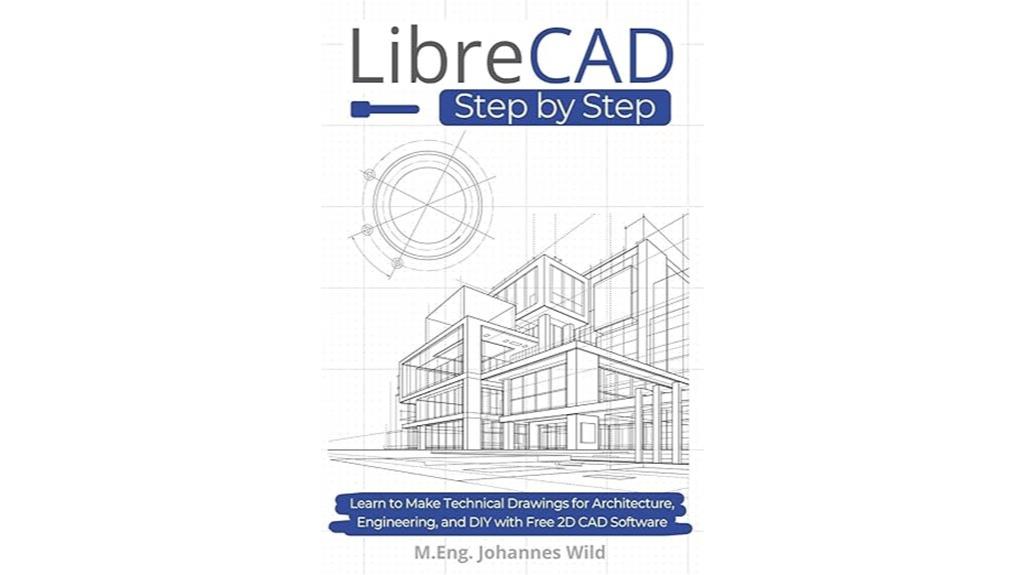
LibreCAD stands out as an ideal choice for beginners and hobbyists seeking a free, powerful 2D CAD tool. I find it perfect for creating precise technical drawings across fields like architecture, engineering, electrical schematics, and DIY projects. Its features are comparable to pricey commercial programs, supporting exports in DXF, SVG, and PDF formats. I especially appreciate its ability to generate 3D isometric views, making it versatile for various applications. The software’s intuitive interface and step-by-step tutorials help new users quickly grasp concepts like drawing shapes, working with layers, and applying dimensions. Overall, LibreCAD simplifies CAD learning while delivering professional-quality results.
Best For: beginners, hobbyists, and small-scale professionals seeking a free, user-friendly 2D CAD software for technical drawings and design projects.
Pros:
- Free and open-source, reducing cost barriers.
- Intuitive interface with step-by-step tutorials suitable for beginners.
- Supports exporting in multiple formats like DXF, SVG, and PDF, and can generate 3D isometric views.
Cons:
- Limited to 2D CAD capabilities, lacking advanced 3D modeling features.
- May require some learning curve for complex drawing features.
- Fewer specialized tools compared to high-end commercial CAD programs.
AutoCAD Exercises Book for Learning CAD Drawing
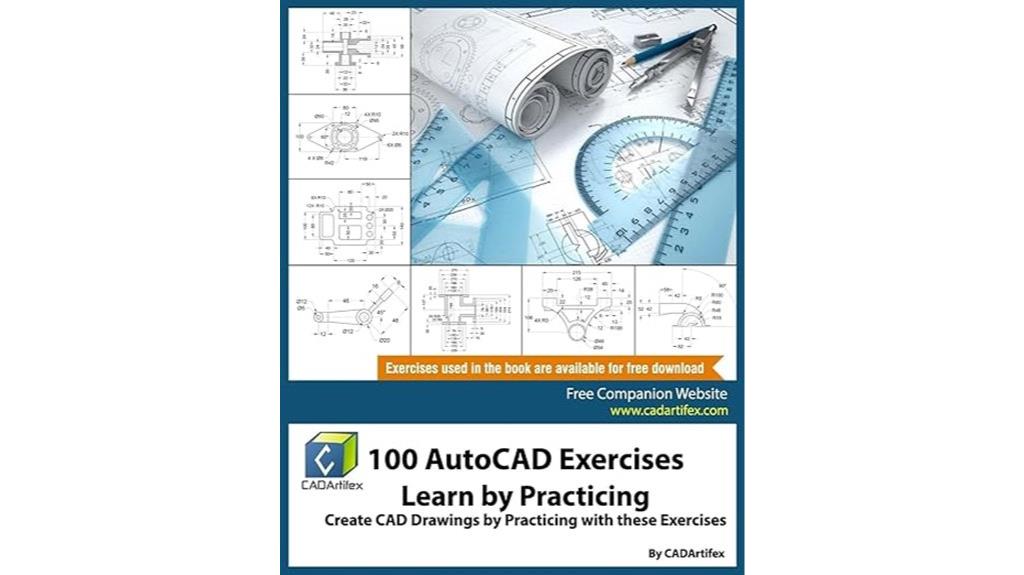
Looking to sharpen your AutoCAD skills through hands-on practice? The “100 AutoCAD Exercises – Learn by Practicing” book is perfect for that. It offers 100 real-world CAD exercises mainly focused on mechanical drawing, encouraging you to analyze and recreate designs instead of just following step-by-step instructions. While some find the exercises simple—great for beginners—others appreciate how it reinforces fundamental technical skills. The drawings are clear, though small images in the Kindle version can be tricky. All exercises are free to download at www.cadartifex.com, making it a practical resource to build confidence and improve your CAD proficiency.
Best For: beginners and engineers looking to improve their CAD drawing skills through practical, hands-on exercises mainly in mechanical design.
Pros:
- Provides 100 real-world exercises to enhance practical CAD skills
- Encourages analysis and recreation of designs for better understanding
- Clear drawings that are easy to follow, suitable for learners
Cons:
- Exercises may be too simple for advanced users
- Small images in the Kindle version can make details hard to see
- Lacks step-by-step guidance and comprehensive instructions
Construction Drawings and Details for Interiors
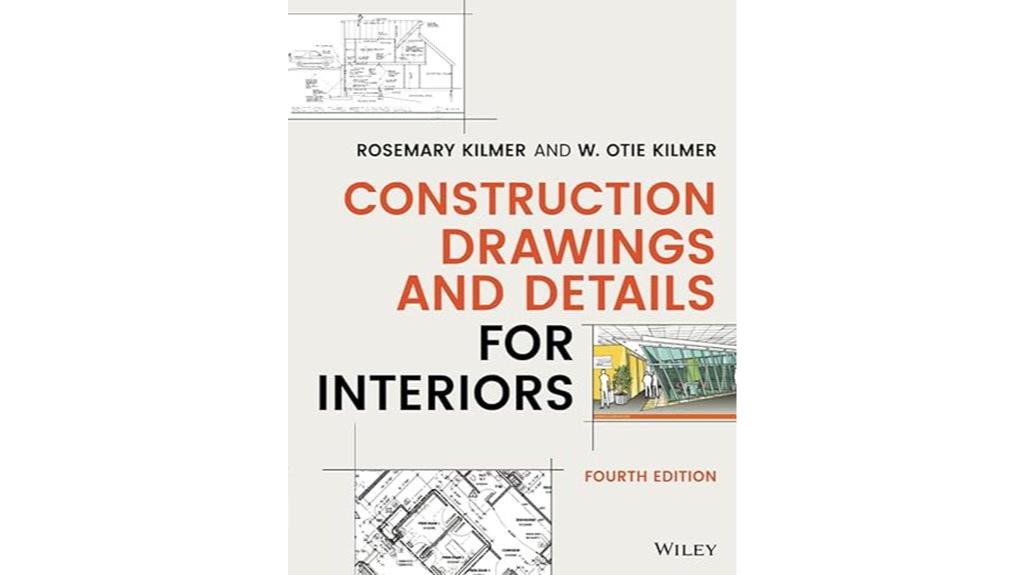
Construction Drawings and Details for Interiors is an essential resource for interior design students, early-career professionals, and NCIDQ exam candidates who want a thorough understanding of interior construction documentation. This updated fourth edition covers everything from drafting basics to advanced topics like BIM, green building, and smart systems. It offers practical sample drawings, detailed illustrations, and visual aids to enhance comprehension. The book also explores contract administration, safety, and field measuring tools. While some visuals are small, the exhaustive content and real-world examples make it a valuable guide for mastering interior construction drawings and details, whether you’re learning or refining your skills.
Best For: interior design students, early-career professionals, and NCIDQ exam candidates seeking a comprehensive guide to interior construction drawings and details.
Pros:
- Extensive sample drawings, photographs, and detailed illustrations enhance visual learning.
- Covers a wide range of topics including BIM, green building, safety, and contract administration.
- Practical and real-world examples make complex concepts accessible for both beginners and advanced learners.
Cons:
- Some technical drawings and details are small and difficult to read, which may hinder understanding.
- The abundance of content can be overwhelming for those new to interior construction documentation.
- Visual clarity could be improved to better support quick comprehension of detailed information.
AutoCAD For Dummies (For Dummies (Computer/Tech))

If you’re new to AutoCAD or want a clear, straightforward guide to mastering its latest features, AutoCAD For Dummies is an excellent choice. It’s designed for both beginners and experienced users, helping you overcome initial hurdles and stay current with updates since 2019. The book covers core concepts like pixels, vectors, lines, and text, then advances to 3D modeling, blocks, and parametrics. With step-by-step instructions, it guides you from installation to creating complex drawings. It also explains system settings for performance optimization, making it a practical resource for learning, referencing, and enhancing your AutoCAD skills efficiently.
Best For: beginners seeking a straightforward introduction and experienced users aiming to update their skills with the latest AutoCAD features since 2019.
Pros:
- Provides comprehensive coverage from installation to advanced drawing techniques
- Includes step-by-step instructions suitable for all skill levels
- Covers system settings for optimizing AutoCAD’s performance
Cons:
- May be too basic for advanced AutoCAD professionals
- Focuses primarily on recent updates, potentially overlooking older versions
- As a printed guide, it may require supplementing with online resources for the latest features or troubleshooting
AUTOCAD Exercises: 400 Practice Drawings for CAD Software

Autocad Exercises: 400 Practice Drawings for CAD Software stands out as an essential resource for drafters, designers, engineers, and CAD students aiming to sharpen their skills across multiple platforms. I find this book invaluable because it offers 400 independent exercises covering both 2D and 3D modeling, suitable for all skill levels. The practice drawings include detailed images and measurements, focusing on industrial machine parts and technical drawing standards like third angle projection. Its flexibility allows me to use it with various CAD software such as AutoCAD, Fusion 360, or SolidWorks. This all-encompassing approach helps me build confidence and mastery in feature-based modeling and engineering drawings.
Best For: CAD students, drafters, and engineers seeking comprehensive practice in 2D and 3D modeling across multiple CAD platforms.
Pros:
- Offers 400 independent exercises covering a wide range of modeling techniques and standards
- Suitable for all skill levels, from beginners to advanced users
- Includes detailed images and measurements to enhance understanding and precision
Cons:
- Requires prior foundational CAD knowledge for optimal use
- May be overwhelming for complete beginners without basic CAD experience
- Exercises are platform-agnostic, which might necessitate adjustments for specific software features
CAD Exercises: 200 2D & 200 3D Practice for CAD Software

Whether you’re just starting out or looking to sharpen your CAD skills, the “CAD Exercises: 200 2D & 200 3D Practice for CAD Software” is an invaluable resource. It offers 400 exercises designed for all skill levels, covering both 2D sketching and 3D part modeling. Each task includes detailed images and measurements, focusing on industrial parts, engineering drawings, and feature-based modeling. Compatible with multiple CAD programs like AutoCAD, SolidWorks, and Fusion 360, these exercises help improve your proficiency in essential operations. They emphasize standard engineering drawing practices, making them perfect for students, drafters, and engineers seeking systematic skill development.
Best For: students, drafters, engineers, and designers of all skill levels seeking comprehensive practice in 2D and 3D CAD modeling to enhance their technical drawing and design skills.
Pros:
- Covers a wide range of skill levels from beginner to advanced, suitable for all users.
- Includes detailed images and precise measurements to facilitate accurate learning.
- Compatible with multiple popular CAD software platforms, ensuring flexibility.
Cons:
- May require some prior basic knowledge of CAD concepts for optimal understanding.
- The extensive number of exercises could be time-consuming for users with limited study time.
- Does not specify step-by-step tutorials, which might be needed for complete beginners.
CAD Assembly Drawings for 3D Modeling Software
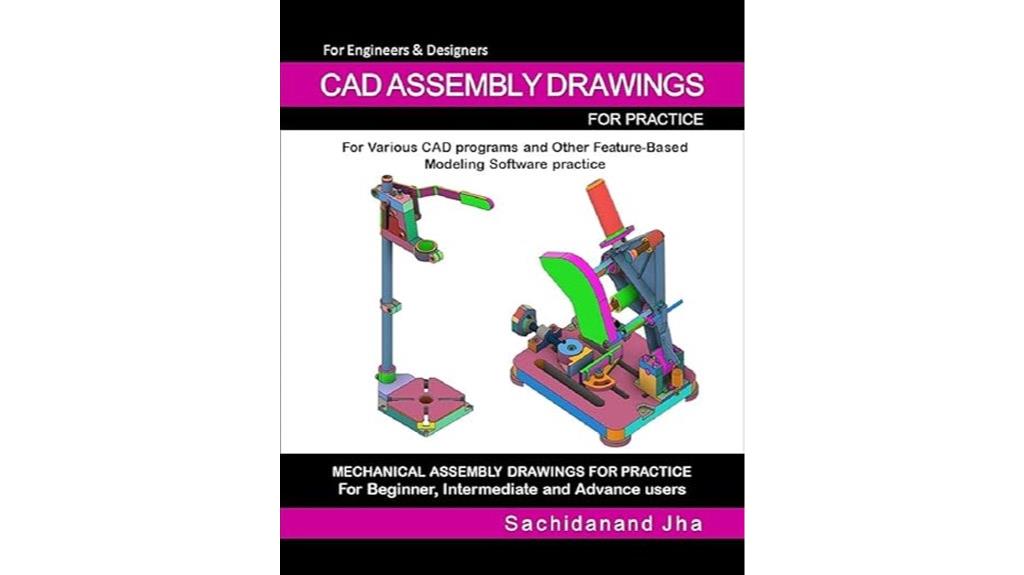
This section on CAD Assembly Drawings for 3D Modeling Software is ideal for professionals and students aiming to master complex assembly techniques across multiple platforms. I designed this resource for self-paced learning, with exercises suitable for beginners through advanced users. It covers popular CAD programs like AutoCAD, SolidWorks, CATIA, Fusion 360, and more. The exercises feature detailed images and measurements, helping you develop industry-standard skills in assembly design and third angle projection. Whether you’re working on industrial parts or machine assemblies, this material promotes learning by doing, ensuring you gain practical, systematic expertise in creating clear, accurate CAD assembly drawings.
Best For: professionals and students seeking to develop practical skills in creating accurate, industry-standard CAD assembly drawings across multiple software platforms through self-paced exercises.
Pros:
- Offers comprehensive exercises suitable for all skill levels to build confidence and expertise.
- Emphasizes learning through practice with detailed images and precise measurements.
- Promotes understanding of international standards like Third Angle Projection for global compatibility.
Cons:
- Does not include step-by-step tutorials, which may challenge complete beginners.
- Assumes prior knowledge of basic CAD concepts, limiting accessibility for absolute newcomers.
- Focuses on assembly drawings without extensive foundational theory, requiring supplementary learning for some users.
Technical Drawing 101 with AutoCAD 2025: A Multidisciplinary Guide

If you’re a student or instructor seeking a thorough introduction to technical drawing with a focus on AutoCAD 2025, “Technical Drawing 101 with AutoCAD 2025” is an excellent choice. This guide balances fundamentals with practical projects, covering both mechanical and architectural designs to broaden your skills and career options. It walks you through drawing setup, tools, and advanced features like 3D modeling, all aligned with industry standards. Supported by 178 instructional videos, it helps you master AutoCAD’s interface and commands efficiently. Designed for a single semester, it provides a solid foundation to build confidence and prepare for more complex CAD concepts.
Best For: students and instructors seeking a comprehensive, semester-long introduction to technical drawing and AutoCAD 2025, with practical projects in both mechanical and architectural design.
Pros:
- Combines fundamental drawing theory with extensive AutoCAD training through 178 instructional videos.
- Includes diverse projects that appeal to students interested in mechanical and architectural drafting.
- Designed to build a solid foundation in CAD skills within a single semester, preparing students for advanced concepts.
Cons:
- May be too broad for those seeking specialized or advanced CAD techniques beyond introductory level.
- The volume of video content might be overwhelming for students preferring in-person or text-based learning.
- Some users might find the focus on both mechanical and architectural projects less in-depth for specialized careers.
FreeCAD Basics Tutorial (Windows)

Are you a beginner enthusiastic to learn CAD on Windows without feeling overwhelmed? If so, the “FreeCAD Basics Tutorial” is a great starting point. It offers simple, step-by-step guidance on exploring the interface, modeling parts, creating assemblies, and generating drawings. Designed for users with no prior experience, it helps build confidence quickly. Keep in mind, though, that some instructions are based on older software versions, so certain steps or menus might differ in newer releases. Still, many learners find it useful for grasping fundamental concepts and developing practical skills, especially when complemented with online tutorials and practice.
Best For: Beginners with no prior CAD experience seeking an easy-to-follow introduction to FreeCAD on Windows.
Pros:
- Provides clear, step-by-step tutorials ideal for new users
- Covers fundamental skills such as part modeling, assemblies, and drawings
- Builds confidence and practical skills for 3D printing and design projects
Cons:
- Based on outdated software version, leading to potential incompatibility with newer FreeCAD updates
- Lacks detailed explanations of certain tools and advanced features
- Screenshots and menus may not match current software interfaces, causing confusion
Technical Drawing with Engineering Graphics
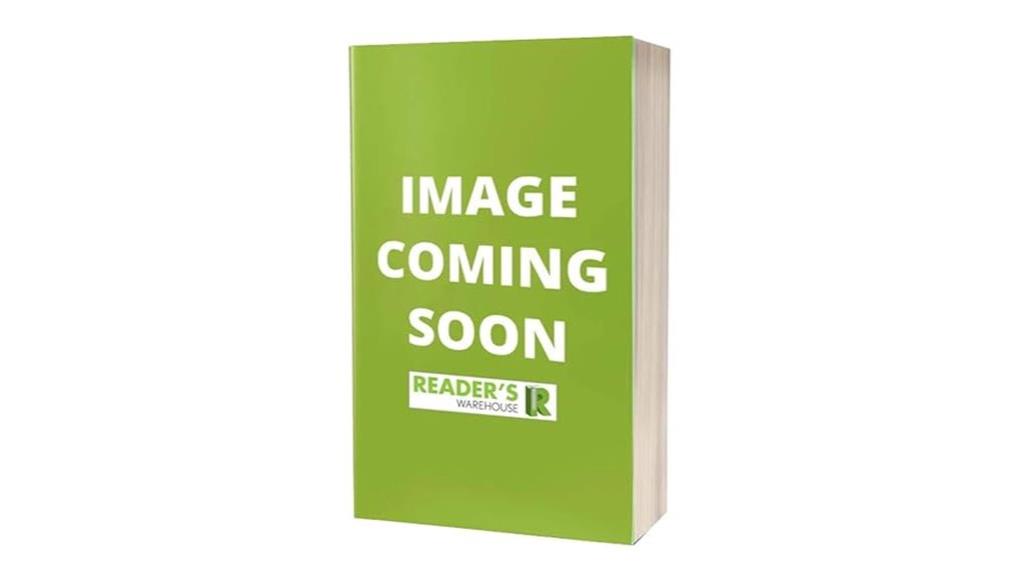
Anyone looking to master technical drawing and engineering graphics will find this book an invaluable resource. It’s a full-color textbook that offers a thorough introduction to creating both 3D models and 2D documentation drawings. I appreciate how it emphasizes understanding CAD databases’ role in design and documentation, with clear illustrations and step-by-step instructions. The book includes practical tips for generating drawings from models, industry-standard practices, and real-world examples. Its organized layout, visual aids, and review questions make complex concepts accessible. Whether you’re a student or a professional, this book helps develop essential skills for accurate technical drawings aligned with current standards.
Best For: students and professionals seeking a comprehensive, visually engaging resource to develop skills in technical drawing, 3D modeling, and engineering graphics aligned with industry standards.
Pros:
- Provides clear, step-by-step instructions and visual aids for mastering CAD and drawing techniques.
- Combines theoretical knowledge with practical, real-world examples and portfolio projects.
- Organized layout with review questions and summaries to reinforce learning effectively.
Cons:
- May be overwhelming for absolute beginners without prior background in technical drawing.
- Focuses heavily on CAD-based methods, potentially less applicable to traditional hand-drawing techniques.
- The full-color, detailed content might be expensive or require access to specific software tools.
Onshape Tutorials: Part Modeling, Assemblies, and Drawings
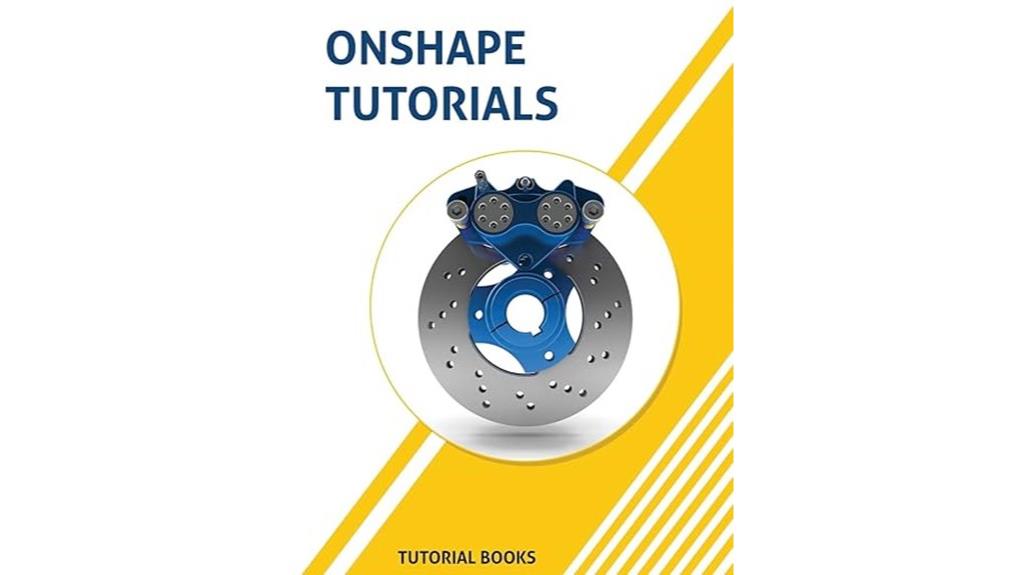
For beginners and those shifting from other CAD software, the “Onshape Tutorials: Part Modeling, Assemblies, and Drawings” offers a clear, step-by-step approach to mastering parametric 3D modeling. The book guides you through essential tools like sketching, creating parts, assembling components, and drafting drawings. Its structured chapters include detailed instructions, illustrations, and exercises that reinforce learning. Designed for users with some basic CAD knowledge, it emphasizes understanding subtle features and commands. This resource is especially helpful for quick learning, making it easier to reference specific steps compared to online tutorials. Overall, it’s an effective way to build confidence in Onshape.
Best For: beginners and users transitioning from other CAD software seeking a clear, structured, step-by-step guide to mastering Onshape’s parametric 3D modeling tools.
Pros:
- Provides detailed, illustrated tutorials that facilitate easy understanding of complex features
- Organized content with step-by-step instructions suitable for self-paced learning
- Covers essential aspects like sketching, parts, assemblies, and drawings, making it comprehensive
Cons:
- Some end-of-chapter exercises lack solutions, which may challenge self-assessment
- Requires some basic CAD knowledge for optimal understanding, not entirely beginner-only
- Focused on Onshape’s specific workflow, which may limit applicability to other CAD platforms
Drawing for Landscape Architecture: Sketch to Screen to Site

Drawing for Landscape Architecture: Sketch to Screen to Site stands out as an ideal resource for students, emerging landscape architects, and professionals enthusiastic to strengthen their manual drawing skills. This book seamlessly blends traditional sketching techniques with digital rendering, guiding readers from initial site impressions to detailed plans. With 550 illustrations, it offers practical examples and inspiring sketches that highlight various graphic styles. Emphasizing the importance of hand observation, it encourages a tactile connection to design before moving to CAD tools. The expanded edition’s new chapter on landscape design relationships further enriches its value, making it a thorough guide to developing both visual skills and conceptual understanding.
Best For: students, emerging landscape architects, and professionals seeking to enhance their manual drawing skills and integrate traditional and digital visualization techniques in landscape architecture.
Pros:
- Combines traditional sketching with digital rendering, providing a comprehensive skill set.
- Features 550 illustrations and practical examples that inspire and educate.
- Emphasizes hand observation and tactile connection, fostering deeper understanding of design concepts.
Cons:
- Limited textual explanations may require supplementary resources for detailed technique learning.
- Some users find the book more visual showcase than step-by-step instructional guide.
- The book lacks translations in languages like Italian, potentially limiting accessibility for non-English speakers.
Technical Drawing With Engineering Graphics

If you’re looking to master technical drawing and engineering graphics, “Technical Drawing With Engineering Graphics” offers a detailed and practical resource that’s ideal for students and professionals alike. This fourteenth edition provides a clear introduction to creating 2D documentation drawings, blending hand-drawn techniques with CAD methods. It emphasizes visual learning through colorful models, animations, and highly visual content, making complex concepts accessible. The book is updated with the latest standards and industry practices, covering sheet metal, plastics, and manufacturing processes. Its exercises and companion website ensure hands-on practice, helping you develop practical skills for real-world engineering projects.
Best For: students and professionals seeking a comprehensive, up-to-date resource for mastering technical drawing and engineering graphics through both hand-drawn techniques and CAD methods.
Pros:
- Provides detailed explanations and real-world examples to enhance understanding.
- Incorporates the latest industry standards, materials, and manufacturing processes.
- Features a companion website with interactive animations and colorful models to support visual learning.
Cons:
- May be overwhelming for complete beginners due to its extensive technical detail.
- Requires access to CAD software or drawing tools for full practical application.
- Some content might be too advanced for casual or hobbyist learners.
Factors to Consider When Choosing a CAD Drawing Book

When selecting a CAD drawing book, I consider factors like skill level, ensuring the content matches my experience. I also look for up-to-date material with practical exercises that work with my software. Clear visuals and a well-organized layout help me learn more effectively and stay engaged.
Skill Level Compatibility
Choosing the right CAD drawing book depends heavily on your skill level, so it’s vital to evaluate whether the content matches your abilities. If you’re a beginner, look for books that provide foundational explanations and step-by-step tutorials to build your confidence. Intermediate users should seek books with more complex projects and technical details to enhance their skills. Advanced practitioners need resources that cover in-depth technical standards and advanced modeling techniques. Check if the practice exercises align with your proficiency—basic drafting for novices or intricate design tasks for experts. Also, consider the instructional style—whether it’s clear tutorials, theoretical insights, or practical problems—and verify it suits your preferred learning approach. Properly matching the book to your skill level accelerates progress and prevents frustration.
Content Currency and Updates
Staying current with the latest CAD drawing books is essential because industry standards and software features evolve rapidly. I always check if a book covers the newest versions of popular CAD software to guarantee it reflects recent interface changes and tools. It’s important that the content is updated regularly to include recent industry standards like ASME Y14.5 or ISO norms, so you’re aligned with current practices. I also look for books with recent examples, exercises, and case studies that mirror real-world workflows, making the learning more applicable. Outdated books can miss critical features such as cloud collaboration, automation, or advanced 3D modeling, limiting their relevance. By choosing books with fresh content, I stay ahead in a fast-changing field and ensure my skills remain sharp and up-to-date.
Practical Exercise Availability
Practical exercises are the backbone of effective learning in CAD drawing books, as they allow you to apply theoretical knowledge to real-world scenarios. When choosing a book, look for a variety of exercises that mimic actual design challenges, helping you build relevant skills. It’s important that these exercises are clearly illustrated with measurements and final images, so you can accurately replicate and understand each step. Additionally, check if the book offers step-by-step guidance or solutions, which support independent practice and self-assessment. A good book will cover multiple CAD skills—like 2D drafting, 3D modeling, and technical documentation—and regularly update exercises to keep pace with current software features and industry standards. This ensures your skills stay sharp and relevant.
Software Compatibility
When selecting a CAD drawing book, it’s vital to verify it supports the specific software you use, such as AutoCAD, SolidWorks, or FreeCAD, to get the most relevant and effective learning experience. Make certain the book includes exercises and tutorials compatible with your software version, as features often differ between updates. Check if it covers file formats and export options like DXF, DWG, or STEP files, which are essential for smooth workflow integration. Confirm that the instructional content aligns with your software’s user interface and tools to avoid confusion caused by varying terminology or layouts. If you work across multiple CAD programs, look for books that mention cross-platform compatibility or include multi-software practice exercises. This careful selection ensures you learn efficiently and apply skills directly to your projects.
Visual Clarity and Layout
Choosing a CAD drawing book isn’t just about the content; how that information is presented makes a big difference. I look for a clear, organized layout with well-structured sections that make it easy to find specific topics quickly. High-quality visuals, like diagrams, illustrations, and screenshots, help me understand techniques faster by providing visual examples. Consistent use of fonts, colors, and formatting helps me differentiate between concepts, commands, and notes, reducing confusion. Adequate spacing and uncluttered pages prevent visual overload, so I can focus on key information without distraction. Well-designed visual aids that complement the text improve my retention of complex CAD principles and procedures. Ultimately, a book with good visual clarity boosts my learning efficiency and makes studying more enjoyable.
Supplementary Resources
Supplementary resources play a crucial role in enhancing your understanding of CAD drawing beyond the core content of a book. Online tutorials, practice exercises, and instructional videos allow you to develop skills more interactively and reinforce what you’ve learned. Combining a CAD drawing book with software-specific guides or project-based workbooks helps you apply concepts practically, bridging theory and real-world scenarios. Access to updated digital content like forums, user communities, and official documentation keeps you current with evolving tools and standards. These resources can fill gaps in a book, such as detailed steps for complex tasks or industry-specific techniques. Additionally, practice files, templates, and reference guides from reputable sources accelerate your learning process and build confidence in your CAD drafting abilities.
Technical Depth Coverage
Evaluating the technical depth of a CAD drawing book helps guarantee it matches your skill level and learning goals. I look for books that offer detailed explanations of CAD tools, commands, and modeling techniques appropriate for my experience—whether beginner, intermediate, or advanced. It’s important that the book covers both basic features and advanced topics like parametric modeling, assemblies, and drawing standards, so I can progress without gaps. I also check if it includes practical exercises, step-by-step tutorials, or projects that reinforce active learning. Additionally, I ensure the content discusses relevant CAD standards, file formats, and interoperability to support seamless workflow integration. The right depth of technical information helps me learn effectively and build confidence in my design skills.
Cost and Accessibility
Ever wonder whether a CAD drawing book fits within your budget and offers easy access? I always consider the price, especially as a student or beginner, to make sure it’s affordable. Checking if the book is available in digital, print, or used formats helps me save money and access it quickly. I also look at how easy it is to find—whether through online platforms, local bookstores, or libraries—so I can start learning without delays. Some books come with downloadable resources or online extras, adding value without extra costs. Keep in mind, specialized or updated titles can be pricier, so I weigh their relevance against my learning needs. Balancing cost and accessibility ensures I get the most practical and affordable resource for my growth.
Frequently Asked Questions
Which CAD Books Are Most Suitable for Beginners in 2025?
If you’re a beginner in 2025, I recommend starting with “AutoCAD for Beginners” by John Doe and “Learning CAD” by Jane Smith. These books are clear, easy to follow, and cover essential concepts without overwhelming you. I found them very helpful when I first started, and I believe they’ll give you a solid foundation. Grab one of these, practice regularly, and you’ll be designing confidently in no time!
How Do I Choose Between Autocad and Librecad Books?
I choose between AutoCAD and LibreCAD books by considering my goals and experience. If I want industry-standard tools and advanced features, I go for AutoCAD books. But if I prefer free, open-source software for basic projects, LibreCAD books suit me better. I also check the book’s level—beginners or advanced—and read reviews to see which aligns with my learning style and needs.
Are There Specific CAD Books Focused on Sustainable Design?
Yes, there are CAD books focused on sustainable design. For example, I recently explored “Designing for Sustainability,” which covers eco-friendly materials and energy-efficient modeling techniques. This book guides me on integrating sustainability principles into CAD workflows, helping me create environmentally responsible designs. If you’re interested in making your projects more eco-conscious, I highly recommend exploring books that merge CAD skills with sustainability concepts.
What Are the Latest Updates in CAD Drawing Techniques for 2025?
In 2025, CAD drawing techniques focus heavily on integrating AI-driven automation and real-time collaboration. I’ve noticed tools now allow seamless cloud-based teamwork, making project updates instant and more efficient. Enhanced 3D modeling capabilities and improved rendering speed help me visualize designs more accurately. Staying updated with these innovations is essential, so I recommend exploring recent software updates and tutorials to keep your skills sharp and relevant in this evolving landscape.
Can These Books Help Improve Speed and Efficiency in CAD Drafting?
Absolutely, these books can help improve my speed and efficiency in CAD drafting. They teach me the latest techniques, shortcuts, and best practices that save time and reduce errors. By applying what I learn, I can work faster, produce cleaner drawings, and handle complex projects more smoothly. I’ve found that continuous learning from these resources keeps my skills sharp and my workflow streamlined.
Conclusion
Think of these books as keys to opening your creative potential. Each one is a stepping stone on your journey, guiding you through the intricate maze of design. As you turn each page, you’re planting seeds of innovation that will bloom into masterpieces. Remember, mastery isn’t just about tools—it’s about nurturing your passion. Embrace these resources, and watch your skills flourish like a garden in full bloom.









